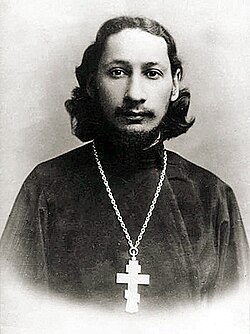Top Qs
Timeline
Chat
Perspective
November 25 (Eastern Orthodox liturgics)
From Wikipedia, the free encyclopedia
Remove ads
November 24 - Eastern Orthodox liturgical calendar - November 26

All fixed commemorations below are observed on December 8 by Eastern Orthodox Churches on the Old Calendar.[note 1]
For November 25, Orthodox Churches on the Old Calendar commemorate the Saints listed on November 12.
Feasts
Saints
- Hieromartyr Clement, Pope of Rome (101)[1][2][4][5][note 2] (Russian use only. See also: November 24)
- Great-martyr Mercurius of Caesarea in Cappadocia (259)[3][7][8][note 3][note 4] (see also: November 24 - Russian use)
- Great-martyr Catherine of Alexandria (305)[2][3][13][note 5] (see also: November 24 - Russian)
- Holy 150 Orators, martyred by fire, with Great-martyr Catherine of Alexandria (305)[14]
- Martyrs Augusta (Faustina) the Empress, by beheading,[15] Porphyrius Stratelates and 200 soldiers at Alexandria, by the sword (305)[1][3][16] (see also: November 24 - Russian)
- Holy 670 Martyrs, by the sword.[17][18][19]
- Hieromartyr Peter, Archbishop of Alexandria (311)[1][2][5][20] (see also: November 24 - Greek)
- Venerable Peter the Silent (the Hesychast), of Galatia and Antioch (c. 403 or 429)[1][2][3][5][21][22][note 6] (see also: February 1)
- Saint Clement of Ohrid, Bishop of Ohrid (Achrida), Enlightener of Bulgaria and Wonderworker (916)[1][2][19][23] (see also: November 22)
Remove ads
Pre-Schism Western saints
- Hieromartyr Moses, a priest in Rome, noted for his zeal in preaching the Gospel and his firm stand against Novatianism, martyred under Decius (251)[6][note 7]
- Saint Jucunda, a holy virgin in Reggio in Aemilia in Italy and a spiritual daughter of St Prosper, Bishop of that city (466)[6][9]
- Saint Alanus, Abbot and founder of Lavaur in Gascony in France (7th century)[6]
- Saint Imma (Immina), born in Würzburg, she became abbess of a convent in Karlburg in Germany (c. 752)[6]
- Saint Bernold, monk-priest of Ottobeuren Abbey in Bavaria in Germany, renowned as a wonderworker (c. 1050)[6]
Post-Schism Orthodox saints
- —
New martyrs and confessors
- Martyr Magdalena Zabelina (1931)[5][24]
- New Hieromartyr Seraphim (Ostroumov), Archbishop of Smolensk (1937)[1][2][5][24][note 8]
- New Hieromartyr Yaroslav Savitsky, Protopresbyter of Moscow (1937)[2][19][24][25]
- New Hieromartyrs Hilarion Soloviev and Simeon Afonkin, Priests, of Alma Ata (1937)[2][19][24]
- New Hieromartyr John Vladimirsky of Tver (1937)[2][19][24]
- New Hieromartyr Cosmas Korotkikh of Moscow (1937)[2][19][24]
- New Hieromartyrs Gregory Voinov,[26] Basil Pariysky, John Tarasov,[27] Alexander Vershinsky, John Janushev,[28] Victor Smirnov,[29] Andrew Shershnev,[30] Priests (1937)[2][24]
- New Hieromartyr Varlaam Popov (1937)[24][31]
- Martyr Paul Kuzovkov (1937)[2][5][24]
- Martyr Nicholas Kopninsky (1938)[2][5][24]
Remove ads
Other commemorations
- Repose of priest Pavel Florensky of Sergiev Posad (1937)[1]
- Repose of Protopriest Rostislav Gan in Australia (1975)[1][32]
Icon gallery
- Translation of the relics of Hieromartyr Clement, Pope of Rome.
- Great-martyr Mercurius of Caesarea in Cappadocia.
- Great-martyr Catherine of Alexandria.
- Martyrdom of Great-martyr Catherine of Alexandria.
- Vision of Peter of Alexandria.
- Saint Clement of Ochrid.
- Hieromartyr Seraphim (Ostroumov), Archbishop of Smolensk.
- Fr. Pavel Florensky.
Notes
- The notation Old Style or (OS) is sometimes used to indicate a date in the Julian Calendar (which is used by churches on the "Old Calendar").
The notation New Style or (NS), indicates a date in the Revised Julian calendar (which is used by churches on the "New Calendar"). - One of the Seventy Apostles, he was the third Pope of Rome. Consecrated by the Apostle Peter, he is mentioned in Philippians 4,3 and wrote a letter to the Church of Corinth which still exists. He is venerated as a martyr and he is remembered in Rome by the church of San Clemente, which may have been built on the site of his home. (In the East: Jan 4, Apr 22, Sept 10 and Nov 25).[6]
- "At Caesarea, in Cappadocia, St. Mercury, soldier, who vanquished the barbarians and triumphed over the cruelty of Decius through the protection of his guardian angel. Finally, having acquired great glory from his sufferings, he was crowned with martyrdom and went to reign forever in heaven."[9] Name days celebrated today include:
- Merkourios (Μερκούριος);
- Mercurius / Mercury.
- The region known as the "Mercurion" (it) in Southern Italy, within the Pollino massif of the Southern Apennines, on the Calabrian-Lucanian border, was a territory where Eastern Greek monasticism flourished for many centuries. Generally, the origin of this name is thought to refer either to the existence of an ancient temple of the god Mercury, or alternatively, to the cult paid by the monks to Saint Mercurius, being a very popular cult in southern Italy during the Middle Ages.[10][11]
The beginnings of the Mercurion in the sixth century and its subsequent evolution is related to several reasons, including the iconoclastic crisis, and the Arab conquest of Syria and Egypt in the sixth century, and of Sicily in the ninth century. The period of maximum splendor of this area was reached in the X-XI centuries, in which the Mercurion was called the "New Thebaid",[12] becoming one of the major centers of mysticism. - "THE birthday of St. Catharine, virgin and martyr, under the emperor Maximinus. For the confession of the Christian faith, she was cast into prison at Alexandria, and afterwards endured a long scourging with whips garnished with metal, and finally ended her martyrdom by decapitation. Her body was miraculously conveyed by angels to Mount Sinai, where pious veneration is paid to it by a great concourse of Christians."[9] Name days celebrated today include:
- Catherine (Κατερίνα).
- "At Rome, St. Moses, priest and martyr, who, with others detained in prison, was often consoled by the letters of St. Cyprian. After he had withstood with unbending courage not only the Gentiles, but also the Novatian schismatics and heretics, he was finally, in the persecution of Decius, crowned with a martyrdom which fills the mind with admiration, according to the words of pope St. Cornelius."[9]
- See: (in Russian) Серафим (Остроумов). Википедии. (Russian Wikipedia).
Remove ads
References
Sources
Wikiwand - on
Seamless Wikipedia browsing. On steroids.
Remove ads






